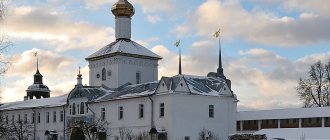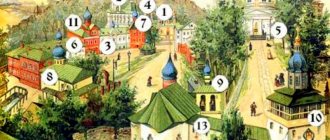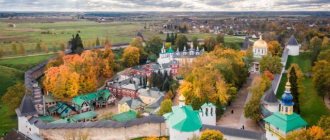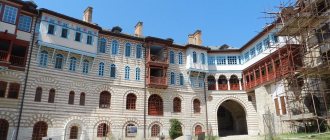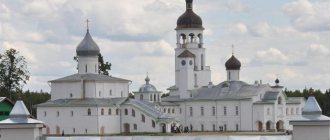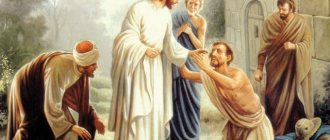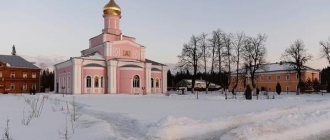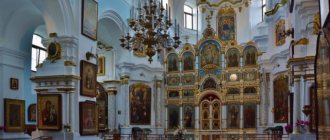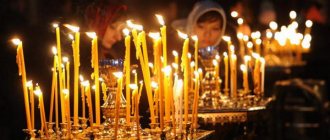The village of Mogochino is located in northern latitudes. In winter there are frosts down to -50 degrees, in summer there is intense heat, and at the end of September the first snow falls on the ground.
| St. Nicholas Monastery in Mogochino | |
| A country | Russia |
| City | Mogochino |
| Year of foundation | 1989 |
| Website | https://mogochinovolok.ru |
| Abbot | Hegumen Matthew Cherevikin |
That is why the construction season here lasts no more than 3-4 months. Construction materials are delivered either by river or by truck across a crossing.
In these harsh conditions, in a field, out of nowhere, Hieromonk John (Lugovskikh) and nun Irina (Seliverstova) managed to found the Mogochinsky St. Nicholas Convent, which became widely known throughout the Orthodox world.
St. Nicholas Convent - a landmark of the village of Mogochino, Tomsk region
The village of Mogochino is located in the Tomsk region on the right bank of the Ob River. This is an ordinary village in the Russian countryside, but what makes it unusual is the St. Nicholas Convent located here.
His address: Russia, Tomsk region, Molchanovsky district, pos. Mogochino.
In order to visit the monastery, you must first get to the village of Narga (221 km from Tomsk), then take a ferry and cross to the other side of the Ob River. In winter, a bus runs across the ice from Narga. There are no other freely accessible routes to the village.
Mogochinsky St. Nicholas Convent during construction. The monastery was built in memory of the exiled settlers who lived here during Stalin's times. Photo: azbyka.ru
The village was founded in 1726. The period of its active development occurred in the 20s of the 20th century. It was then that a large woodworking enterprise was built here.
In Soviet times, Mogonchino was a place of residence for exiled settlers, kulaks, and deported Germans.
After the closure of the wood processing enterprise in the 1990s, the area became unpromising and young people left it. Nowadays, the majority of local residents are pensioners. The population of the village barely reaches 3,000 people.
October 1, 1989
date of foundation of the Mogochinsky St. Nicholas Nunnery
In fact, Mogochino cannot be called either a village or a workers’ settlement, since there are no industrial or agricultural enterprises on its territory. In our time, the Orthodox St. Nicholas Convent is recognized as the center around which life in the village glows.
It was founded on October 1, 1989 and was built entirely through donations. The construction of such a large-scale monastery in the outback is associated with the feat of those innocently exiled to the village during the repressions.
The village of Mogochino, Tomsk region, during a flood. Most of the residents of the village of Mogochino left. Now the center of life in it is the St. Nicholas Convent. Photo: i.ucrazy.ru
In addition, the founders of the monastery pursued the goal of purifying ancient pagan elements that had not yet encountered church grace. Around the monastery since its foundation there has been something resembling an Orthodox community in which volunteer clergy live.
People from all over the country come to Mogochino; the monastery annually attracts hundreds of pilgrims. A hotel was built for them at the monastery.
With the blessing of the rector of the Church of the Resurrection, Priest Dionisy Melentyev, a pilgrimage trip to the St. Nicholas Convent, which is located in the village of Mogochino, Tomsk region, was organized. The trip took place on September 2-3, 2021.
There were 13 pilgrims together with our spiritual leader, Father Alexy Meshcheryakov. Having enlisted the support of Nikolai Ugodnik, we set off on a long journey. The day promised to be sunny and warm. On the way, we glorified the Mother of God with an akathist. Looking ahead, I note that our long journey to the monastery and back went easily and smoothly, thanks to the care of heavenly intercessors.
On the way to Mogochino we made a slight deviation from the planned route, stopping in the village of Molchanovo to visit the local Church of the Transfiguration of the Lord.
This small village church made a very warm impression! White outside and inside, clean, with homemade rugs laid out everywhere, it pleased all the pilgrims. After admiring it and taking a group photo as a souvenir, we drove to our destination.
Taken from the site https://molchanovo.cerkov.ru
Whether it was long or short, we reached the Ob River, gray and inhospitable in autumn, and greeted us with a strong gusty wind. We crossed to the other side on an old, rattling ferry, which I personally saw for the first time.
Then again we ride on our bus for about 5-7 minutes and then - hello, St. Nicholas Monastery! We've arrived. God bless!
Monastery wall and entrance to the monastery territory.
Entrance to the temple. Taken from the site https://gorod.tomsk.ru/index-1377379897.php
Taken from the site https://azbyka.ru/palomnik/index.php?curid=19038
Against the background of low-growing village houses, the monastery looks very impressive and majestic. The domes of the temple are visible from several kilometers away.
A little information . Work on the construction of the monastery began in 1989 under the leadership of monk John (Lugovskikh). The current abbess of the monastery, nun Irina (Seliverstova), said that it was a difficult period. In those years, the village of Mogochino was very rich - four timber industry enterprises. But the residents did not want the monastery to be built. Twice fire destroyed the beginnings of the monastery buildings. The director of the timber industry enterprise refused requests to donate timber for the construction of the monastery. And what is the outcome? Timber industry enterprises disappeared in the 90s. The village is barely breathing. But the monastery still stands. It is now a “city-forming enterprise” in Mogochino. That's the whole moral.
We were accommodated in a hotel for pilgrims. The rooms turned out to be unexpectedly cozy, bright, with modern furniture.
Living room
Refectory
We were pleased with the amenities and water from the tap, contrary to the frightening stereotypes - since it’s a village, then there are amenities “in the yard” along with a washstand. There are sofas along the walls in the corridor. A lot of. It turned out that these were additional sleeping places for pilgrims. There aren't enough of them either. They put cots in the refectory. Mother Daniela is in charge of the hotel and refectory, strict in appearance, but kind in reality. She has been living in the monastery for 24 years, almost since its foundation. Now she is about 60 years old. Talkative, humorous, a microbiologist in her past - worldly life. Her obedience is cleaning the rooms for pilgrims and preparing food for them. She also does repairs and much more alone. The monastery is for women, there is no one to rely on. Mother soon called us to dinner. The monastery food turned out to be very tasty - soup, porridge, compote, vegetables from the monastery garden. And also bread - delicious, in a hole. It turned out to be yeast-free. Mother Daniela said that bread is baked right there in the monastery, using a special leaven brought a long time ago from the monastery in Jerusalem. They treat food with care in the monastery - we were ordered to finish everything without leaving a trace. Otherwise, they will put you in a dark room. This, of course, is Mother Daniel’s joke, but with meaning. The road, as it turned out, exhausted us. There was little time before the evening service and everyone happily fell into bed to take a nap.
At 17 o'clock the evening service began, and we hurried to the temple. There were a lot of people! Mostly, of course, these are pilgrims, local residents, and nuns. Among the nuns there are also very young ones - almost girls. And what was very striking was the large number of children. For them, in the church, not far from the altar, there is a rug laid so that the children can sit there during the service.
We were told that the temple has a very large choir. Indeed, the choir's singing is simply amazing! Beautiful iridescent, sonorous voices that give you goosebumps.
I was especially impressed by the exit of 14 priests from the Royal Doors! A majestic and awe-inspiring sight. And the voices of the monastery deacons—four of them took part in the service—seemed to shake the temple walls. So strong and beautiful! The Bolshoi Theater would accept them without competition. In general, I can convey the general impression of the evening service in one word: “Powerful!” In the temple, the Grace of God is simply very tangible! For a brief moment, I physically felt the presence of Christ while reading the evening prayer rule. He stood in front of the altar facing us. Amazing feeling.
By the end of the service, a huge line of people wishing to confess had formed. On this evening, confession was received by Father Matthew, known throughout Siberia. People say that through his prayers the sick are healed and difficult situations are resolved. We did not manage to get to confession with this elder; there were too many people who wanted to go without us.
During the service, I noticed a very elderly priest, bent at the waist, leaning heavily on a stick. This, as I later found out, was Archpriest Ioannikiy (Anika) Ekimovich Kiryanov, he is now 84 years old! In addition to the service, he took part in the reading of the Akathist to the Mother of God and attended the evening prayer rule. What's surprising about it?
Personally, I was struck by the strength of his spirit, which allowed him to endure the full brunt of his earthly assignment, given his venerable age and illness. I felt ashamed. There are so many reasons not to read the prayer rules or to miss services in church, justifying it with fatigue or sores. Now, when the boring internal dialogue starts up once again - “to pray - not to pray,” I remember this man, ashaming myself of his feat.
The monastery has a special order of services. After the evening service at 22-00 - an akathist to the Mother of God, then an evening prayer rule, then a general confession. My first experience of such a confession. Home - to the hotel, we returned closer to midnight, physically very tired, shifting a huge number of impressions in our heads. The monastery gates were not yet closed, because Father Matthew received confession from pilgrims who stopped “outside the gates” of the monastery.
Early in the morning, at 6:45, unction was performed in the church. Many women from our group decided to participate in this sacrament. They said that there were a lot of people who wanted to receive unction, but everything went quickly, because some priests read prayers, while others anointed them with oil. The sacrament is performed daily. As many years of monastic practice show, after unction, sick people often feel relief mentally or physically.
Sunday liturgy passed in one breath. Abbot John gave a short sermon. At first glance, Father John looks like a stern man. But this impression is deceptive; amazing kindness and love emanate from him.
Hegumen John. Photo taken from the site https://www.liveinternet.ru/users/nataiv/post167404650
Again there were many who wanted to be cleansed of their sins. But I counted eight priests accepting confession. Even on the street people confessed. Our group formed a line to see “our” priest, Father Alexy. It’s almost like being at home – in our native Church of the Resurrection. Our entire women's team confessed and received communion. And there was no formality in this! They worried, sighed, re-reading their sins on the sheets of paper. And after Communion they glowed!
Taken from the site https://azbyka.ru/palomnik/index.php?curid=19040
After the liturgy, I managed to find some time to walk around the church and take a few photographs - I had Father Matthew’s permission to do this. Let me make a reservation right away: some of the photos for my essay were taken from the Internet. We were very limited in time to take photos of what we wanted. And, besides, in a church during a service, photographs turn out to be uninformative - there are many people in the frame and it is difficult to choose an angle, since you are closely surrounded by worshipers.
I'll tell you about some icons. One of them, St. Anne, the mother of the Blessed Virgin Mary, attracts special attention. Attached to the icon are jewelry chains, watches, and crosses left by parishioners to Her in gratitude for her prayerful intercession before the Lord.
Here is an icon of St. Spyridon of Trimythous, under the icon is part of his slipper. The relics of the saint rest in the Cathedral of St. Spyridon of Trimythous in Greece on the island of Corfu. For many years the relics remain incorruptible. Through the glass of the raki you can see teeth, skin and hair. The clergy annually change the shoes and clothes of the Saint, as they wear out. There is a legend that sometimes he goes to wander the earth and helps the suffering.
There is a Holy Cross icon of the Blessed Virgin Mary in the monastery. Every day a water prayer service is held in front of it. The Holy Cross Icon of the Mother of God was painted with the blessing of Metropolitan Gideon of Stavropol and Vladikavkaz after the events associated with the hostage-taking in the city of Budennovsk. Eyewitnesses claim that Her image appeared in the sky after the hostage taking. The vision continued for several days until the day of their release.
Taken from the site
Before heading back we ate lunch. On the occasion of Sunday there were sweets - sweets for tea and watermelon. Having said a warm farewell to Mother Daniila, our group boarded the bus and set off on our way home. Along the way, we shared our impressions, discussed what we saw and experienced. Of course, the trip was a great success!
The journey would not have been so rewarding and successful if it had not been for Father Alexy. He took very warm and touching care of us, answered our many questions, and supported us with his optimism and jokes. On behalf of our entire friendly pilgrim group, I will allow myself to express gratitude and low bow to Father Alexy for his work.
Reviews from some of the trip participants.
Ekaterina Kun . I didn't expect to see so many pilgrims! There are a lot of them - they are Kemerovo, from the Altai Territory. The choir is so beautiful - you'll have to listen to it. Very beautiful! The choir alone is worth the trip. There is a sense of piety in the voices of the elders when they read their prayers. There are a lot of children and sick people at the services. I would like to note that in monasteries the food turns out to be very tasty because it is prepared with prayer.
Galina Tsvetkova . During the trip, a lot happened - they were sprinkled with holy water, anointing, confession, and communion. We were very tired on the first day. But the fatigue passes, but the deep impression remains forever! Everything is unusual. Another world. And you won’t believe that the monastery was built relatively recently. And I would also like to note that it is very good to travel with Father Alexy. He's so wonderful. Thanks to him for everything!
Olga Shatskikh . When I arrived home, I tried to talk about the grace that I encountered in the monastery, but I really couldn’t - tears were welling up. It was both sweet and bitter. And now the faces of the priests, nuns Daniela and Dosithea, and other nuns involuntarily emerge in my memory. The faces of the sisters - pilgrims and the youngest of them - 8-year-old Geli. And I can’t count how many times Father Alexy called us “my dear ones”! There is peace and tranquility in the heart. God bless!
Angelinochka Kuzevanova (8 years old) . I went to the monastery with my grandmother. Father o. Alexy, who traveled with us, is very kind and polite. At the monastery hotel, Mother Daniela greeted us very cordially. The prayer in the temple was very strong, since the service was led by several priests at once. What I liked most was the choir; they sang the prayer very beautifully. Wonderful people work at the monastery! Mother Daniela even gave me an icon of the Mother of God. Which made me very happy! Now I always carry the icon with me and pray. I would love to visit the monastery again. I advise everyone to go there. Thank you all so much for an unforgettable trip!
Parishioner of the Church of the Resurrection, trip participant Lyubov Demidova.
Social buttons for Joomla
The Mogochinsky Monastery was founded by Hieromonk John (Lugovskikh) and nun Irina (Seliverstova)
Mogochinsky Monastery was founded on October 1, 1989. It was then that Hieromonk John (Lugovskikh) came to the newly opened St. Nicholas parish with nun Irina (Seliverstova).
They equipped a village house as a temple, and also purchased three nearby houses. This became the basis of the territory of the future monastery.
St. Nicholas Monastery in the village of Mogochino. Mother Irina Seliverstova. Mother Irina is one of the founders of the St. Nicholas Monastery in Mogochino. Photo: radiologos.ru
The monastery was built without centralized funding, solely through donations. The founders of the monastery attribute its appearance to the feat of those innocently exiled here during the period of repression.
In addition, they also wanted to bring the Christian faith to the ancient pagan area. That is why the construction of the monastery took place in the most difficult conditions, since in the village, which is 270 years old, there has never been a church or roads. Everything needed was brought here by river.
John Lugovskikh in 1998 became the confessor of the Mogochinsky St. Nicholas Convent.
This area has a harsh climate: in winter frosts reach -50 degrees Celsius, in summer it is hot, snow falls already at the end of September. The construction season therefore sometimes lasts only 3-4 months. Construction materials must be delivered either by river or by truck via ferry or ice crossing.
Archimandrite John (Lugovskikh), abbot of the Transfiguration Bolshevolotsk Monastery, confessor of the St. Nicholas Mogochin Convent of the Tomsk Metropolis. The founder and builder of these monasteries. Photo: iskitimeparhia.ru
Hegumen John (in the world Vasily Mikhailovich Lugovskikh) played a major role in the construction of the Mogochin St. Nicholas Monastery. At the age of 35, he was called to church service by hearing the words of the Mother of God: “Come to work with Me.” Father John built many churches.
In April 1993, by decree of Bishop Tikhon of Novosibirsk and Barnaul, Father John was approved as abbot of the Transfiguration Monastery in the former village of Bolshoy Volok, 14 kilometers from Mogochino, and in May of the same year, Bishop Tikhon elevated Father to the rank of abbot.
In 1998, with the blessing of Bishop Arkady of Tomsk and Asinovsky, Abbot John was appointed confessor of the St. Nicholas Monastery.
LiveInternetLiveInternet
Sunday, May 22, 2011 06:56 + to quote book Continuing to browse information about convents in Tomsk, I found the St. Nicholas Convent, which is approximately 200 km from Tomsk.
Moreover, you can only get to the village of Narga by bus. Behind Narga, about 3 km on the right bank of the Ob, there is the ancient village of Mogochino. He is already 285 years old.
The grandiose building of the St. Nicholas Convent is located in this village. The monastery, of course, surprises with its enormity, tall walls, majestic temple and numerous vaulted windows in the buildings. Everything is made of stone and monolithic concrete. Among the squat buildings of Mogochin, this is the Kremlin. And taking into account the impassability and the devastation reigning around - a miracle
.
It has been built by Father John and devotees since 1989. For more than ten years, Abbess Irina (Seliverstova) has been leading the choir of the monastery in Mogochino. For five years, the temple under construction was painted by Novosibirsk artist Vasily Dvortsov.
Everything was and is still being done exclusively “with donations and God’s help.” Twice a fire destroyed all their work. Even the newly built church burned down. They built a new one. Even better.
The Orthodox community, which already has about seven hundred people, is constantly growing. Simultaneously with the construction of the buildings, the inside of the temple was decorated.
One Tomsk benefactor donated a chandelier. The precious cargo did not enter the passenger car, so the donor had to travel from Moscow in a freight car, but the chandelier was delivered completely intact. At first, the residents of Mogochin were hostile to the construction of the temple, but little by little their priorities changed. Those who have visited the monastery at least once have felt the grace-filled help of monastic prayer.
And the village of Mogochino itself is currently barely breathing. The timber mill where he used to operate has been torn down. Mogochin residents remember him with nostalgia. The enterprise was one of the most powerful in the country. There were as many as seven Berezka stores operating in the village, selling scarce imported goods. But the Mogochi people themselves sawed off the branch on which they were “sitting.” They cut down all the valuable forest for about seventy kilometers around us. The new one will now grow only in a hundred years.
The only developing “enterprise” in the village is the monastery. Moreover, its population is not limited only to those who live in cells. There is also a community “behind the fence”, which numbers about a thousand people. They come to the monastery from everywhere. Including from Israel, Poland, Moldova, Kyrgyzstan, Ukraine... But the majority are Siberians.
All the infirm are accepted into the monastery. That is, people who are no longer needed by anyone. In the world they will perish. And those who know the life of other monasteries are surprised at this. They don't take them there. And Father John always says: “bear each other’s weaknesses.”
Mogochin monks are not hermits in their cells. And they cannot be, because you will not be satisfied with prayers alone. All able-bodied people are laborers on a construction site from morning to night. There are about five hours left for sleep. There is practically no free time.
It is noteworthy that over the previous three centuries, there was never a temple in Mogochino. But there was an NKVD commandant’s office. And there were Gulag zones around. And in the ground here lie without any crosses - thousands of innocent people. They have long said about these places: “God created paradise, and the devil created the Narym region.”
This monastery is currently the city-forming enterprise of the village of Mogochin. The largest local landowner. To protect against floods there is a dam, which the monastery helped build.
Father John (in the world Vasily Lugovskikh) was born in Altai into a family of believing parents. He was the youngest, twelfth child. At the age of fourteen he was left without a father. I studied at a vocational school and after the army I attended an evening technical school and at the same time worked at class=”aligncenter” width=”750″ height=”500″[/img] I rose to the rank of shift supervisor. For several years he worked at the Novosibirsk diocese “with a broom and a shovel.” This was the period of his gradual break with worldly vanity. Then he built a temple in Cherepanovo. He was tonsured a monk in 1988 with the name John. At first glance, Abbot John looks like a stern man. But this impression is deceiving. He believes that the monastery is his cross. “And having taken up the cross, you need to follow the path of faith and virtue. Where does this path lead? I know! To Golgotha." - he says.
A person leaving the world and coming to a monastery must act according to the commandment of Christ: “If you want to be perfect, go, sell your property and give to the poor, and you will have treasure in heaven, and come and follow Me.” Many of those who arrived there do not look back, with faith and patience they follow the path of obedience: they work, raise children, and wage an invisible battle with their passions. All questions and perplexities along this path are resolved with their confessor.
In difficult cases, they go to Father John or Mother Irina. People often stand near the doors of the abbot's building or the altar, waiting for a conversation with the governor, abbot John. Mother Irina also constantly listens, consoles, helps with advice, a kind smile, and a kind word. But if necessary, both of them can harshly ask for disobedience and cut off unnecessary conversation. It is no coincidence that they are called here “our parents.” They really, like kind and strict parents, take care of their spiritual children, help spiritually and materially.
Abbess Irina (in the world Nadezhda Alekseevna Seliverstova) was born on September 25, 1948. She grew up in an Orthodox family; her mother dreamed of becoming a nun since childhood. After school, Nadezhda went to work as a hairdresser, but when she got sick, she began singing in the choir in the Ascension Cathedral in Novosibirsk. From 1981 to 1986 she traveled as a psalm-reader to newly opened parishes of the Novosibirsk diocese. On July 8, 1984, she was tonsured a monk in honor of the Great Martyr Irina. Since 1986, she was a psalmist in the Church of All Saints in the city of Cherepanovo, where Vasily (later Hieromonk John) served then. At the same time, mother was sent to Mogochino and received the obedience of a psalmist in the St. Nicholas Church. From the first day in Mogochino, Mother Irina led the monastery choir. Through her efforts, there are already two choirs - a large one and a children's one. As Father John said on the day of her anniversary: “Abbess Irina is the beauty and splendor of church singing in the monastery.”
Information from here: https://sibirica.su/glava-pervaya/zachem-oni-uchodyat-v-monastir/stranitsa-4-3 https://www.diveevo.ru/2/0/1/1127/ https: //monashestvo.narod.ru/str_017.1997.htm https://www.proshkolu.ru/user/irinaputilova/blog/75574/ https://dokisom.ru/143/183 I wanted to go to this most interesting in my opinion place, but you need to go there for two days, which is still unrealistic for me.
| Categories: | Impression |
Tags:
orthodoxy travel monastery traditions
Cited 1 time
Like share
0
Like
- I liked the post
- Quoted
- 0
Saved
- Add to quote book
- 0
Save to links
Liked
0
The hieromonk laid out the foundation of the future church of the monastery already in the first days of his arrival in Mogochino
Arriving in Mogochino, which happened in early October 1989, Hieromonk John marked the foundation of the future church. Metropolitan Gideon (Dokukin) of Novosibirsk and Barnaul blessed Father John to bring workers laid off from the local RSU to the village. They became the first builders of the monastery.
Metropolitan of Novosibirsk and Barnaul Gideon (Dokukin). Metropolitan Gideon gave his blessing for the construction of the St. Nicholas Convent in the village of Mogochino. Photo: orthedu.ru
By November 14, they poured concrete for the foundation of the temple. Metropolitan Gideon blessed the caretaker of the diocesan administration, Ivan Andreevich Sosnin, to deliver bricks for the construction of the church of the future monastery. A few years later he took monastic vows.
The first builders of the St. Nicholas Convent were workers from the local RSU.
In 1990-1991, the monastery's builders erected the white stone walls of its church, as well as a bell tower and a cinder-cast garage. Father John gave his blessing to use only ancient construction technology during the construction of the temple, without using modern measuring tools.
As a result, the building of St. Nicholas Church has slight asymmetry, which gives it a lively appearance.
St. Nicholas Church of the Monogochinsky St. Nicholas Convent. Since the temple was built using ancient technology without the use of measuring tools, it looks picturesque. Photo: znaigorod.ru
In 1992, the roof of the temple was erected and it was plastered from the inside. At the same time, manual excavation work began, aimed at digging pits for the foundation of the monastery walls-buildings. By autumn, concrete underground cubes 50 meters long and 10 meters wide were poured.
In the period from 1993 to 1995, the builders of the monastery built on this foundation the southern and eastern buildings of the Mogochin St. Nicholas Convent, three floors high.
In the 2000s, the Mogochin St. Nicholas Convent was mainly built
The entire year of 1996 was devoted to excavation and concrete work on the construction of the “zero cycle” of the monastery building that closes the circle. They ended by autumn.
In the early spring of the following year, the builders of the monastery began large-scale construction, in which all local residents and inhabitants of the monastery were involved.
In one season, a three-story building in the shape of the letter “P” was built, closing the circle of the monastery.
Mogochino, construction of the St. Nicholas Convent. In 1998, the towers of the monastery were built. Photo: azbyka.ru
In 1998, the white stone towers of the monastery were built, and drainage communications began to be dug. A year later, concrete pouring began on the monastery territory. The final work on the construction of the monastery took place in the two thousand years.
So in 2001, the construction of the hotel building of the St. Nicholas Convent began. In addition, this year it was also necessary to restore the St. Nicholas Church, which was damaged by fire.
2001
this year not only the construction of the monastery began, but also the repair of the temple after the fire
In 2002, a building with a hotel and a garage was built at the monastery church. A year later - the Church of the Intercession of the Blessed Virgin Mary.
Repair work was also carried out. So the third floors of the southern monastery building, the abbot and part of the western building were demolished and rebuilt, and a gate tower was built.
Procession of the cross in the Holy Transfiguration Church under construction. Materials for its construction began to be imported after the completion of the construction of the St. Nicholas Convent in Mogochino. Photo: volokskit.ru
In 2005, the construction of the St. Nicholas Convent was basically completed: the circle of battlements and towers on the monastery walls was completed, a transition was made between the building of the Intercession Church and the western wall, and new cells were built in the southern building.
A year later, preparatory work was carried out for the construction of cells in new buildings, and the delivery of building materials to the village of Bolshoy Volok for the construction of the Holy Transfiguration Monastery began.
Hegumen Matthew (Cherevkin) - the oldest monk in Mogochin
On November 4, 2021, at the age of 71, the founder of the St. Nicholas Monastery and the long-term abbot of the Spaso-Preobrazhensky Monastery died suddenly. Big Volok Archimandrite John (Lugovskikh).
On June 23, 2021, Abbot Matthew (Cherevikin), a resident of the monastery, was appointed in his place. Father Matthew lived for many years in the village of Mogochino, participating with his own labor in the construction of the St. Nicholas Monastery.
Abbot Matthew (Cherevikin). Father Matthew is the rector of the Spaso-Preobrazhensky Monastery under construction in the village of Bolshoi Volok and the most famous elder in Mogochino. Photo: svjatoynarym.ru
Hegumen Matthew was born (in the world Arkady Yurievich Cherevikin), September 6, 1947. Graduated from the Faculty of Mathematics of Novosibirsk State University.
He worked for 22 years at the Novosibirsk Branch of the Institute of Precision Mechanics and Computer Technology. Received Baptism in the Ascension Cathedral in Novosibirsk in 1989.
Father Matthew (Cherevikin) is the most famous elder in Mogochino.
In March 1992, Father Matthew arrived in the village of Mogochino, Tomsk region. Here this year he took monastic vows. He worked on the construction of the newly built St. Nicholas Convent.
He also participated in the construction of the Spaso-Preobrazhenskaya men's monastery in the village. Big Volok. During this time, he acquired a wealth of experience in monastic life and then often said the following: “we all studied in Mogochino.”
The building of the Tomsk Theological Seminary. Father Matthew graduated from the Tomsk Theological Seminary and for a long time spiritually cared for its students. Photo: upload.wikimedia.org
On December 4, 1992 he was ordained a hierodeacon, and on December 10, 1997 a hieromonk. In 2003 he graduated from Tomsk Theological Seminary. In 2004 he was elevated to the rank of abbot. On August 20, 2021 he was awarded a cross with decorations.
Repeatedly took part in pilgrimages to Holy Mount Athos. Here Father Matthew became acquainted with the thousand-year-old tradition of Svyatogorsk monasticism.
Numerous pilgrims of both the St. Nicholas and Spaso-Preobrazhenskaya monasteries consider him an elder, and when they come to the monasteries, they find spiritual nourishment and support from him. In total, Abbot Matthew has more than 25 years of experience in monasteries.
By leaving a comment, you accept the user agreement
Why do they go to a monastery?
Page 3 of 4
DUAL POWER
The trip to the “village council” was a fundamentally important point of my business trip. A fateful redistribution of property is about to take place in Russia. The state is preparing to return to religious organizations what was taken away after the revolution. The vast majority of churches and monasteries still do not belong to the Church. Just like the earth. All this is now in the hands of the authorities, acting as the lessor. And in Mogochino for almost twenty years there has been direct interaction between the state and the Church, where each party acts as a full-fledged subject.
True, the Mogochin government has weak management resources, and the monastery is a “heavyweight”. According to Soviet criteria, it is a city-forming enterprise. The largest local landowner. Is this a biased comparison? But according to experts, the Orthodox Church, after the restoration of “historical justice,” should also become the most powerful non-state owner in Russia.
I immediately remembered the words of Alla Detlukova. She said them, specifically emphasizing that she was speaking on behalf of the authorities, as the head of the settlement:
- In Mogochino, the Church is not actually separated from the state... And if fate turned out so that God gave us a monastery, then we must live based on this reality! Although many do not understand this. When the gate tower in the monastery leaned, the authorities from above flew in, following a complaint from the population. And one of the managers says: “Come on, destroy everything!” But he doesn’t know our life at all, and I answered him: “As long as there is no father’s blessing, I won’t do anything!” And he told me: “Aren’t you the head here?!” No, he doesn’t understand anything... We have two powers here. We are perhaps the only such village in the country. And we must start from life. Maybe that’s why we exist peacefully. Without invading each other's spheres. We are the only people. And we do the same thing.
There will be a long pause when I ask the Governor of the Tomsk Region, Victor Kress:
— Who owns the real power in Mogochino today?
“The monastery there plays a very important role in local life...” he began to speak, choosing his words carefully. — The backbone of the community, thanks to Abbot John, has been created strong. And this is very important, because the village is deeply depressed... To be honest, I myself am not such a strong believer. At least I don’t cross myself in plain sight, as some do. But I believe that there should be a spiritual core in each of us. And it is in this regard that the Church can seriously help in strengthening it.
— Using the example of the Tomsk region, can we talk about the real separation of the Church and the state?
- Legally? Yes. And in life... Well, what kind of division can there be in Mogochino?! Just like in some other small villages where there is a church. But what can I say when I myself obliged all heads of administration to promote the construction of churches. We will help financially, as we did in previous years. Within the law. And I think that this is a good thing.
From a conversation with Mother Joanna, who completely parted with her property in the world, and gave all her personal money to the needs of the monastery.
“Humbling yourself and tolerating people is the most difficult thing in monastic life,” she says. — At first, many people came to us not under the influence of the heart, but for the sake of the stomach. Here they give you a corner and porridge. And as the city began to relax, wages began to be paid - they started to go back. Now there are more of those who have come to save souls. The world does not know the purpose of human life. But I don't blame them for this.
- Mother Joanna, it seemed to me that now people go to the monastery not only for spirituality, but also for kindness...
- Mostly we have here those who have been thrown away by life. And we live according to the commandments of Christ. Now, if I quarrel with someone... Then my prayer doesn’t work. I have no peace in my soul. And that person is also suffering. I fall into his lap: forgive me, I say. We hug him. And this is not pretentious. This is a need. This is in order to restore peace in your soul. You understand that the evil one pulled your tongue...
“This “ritual” of forgiveness takes a secular person by surprise, but, nevertheless, one of the nuns told me that “she did not become any less of a sinner in the monastery”...
“I’ll say the same thing about myself.” It’s just that the closer you are to the light, the more stains you see on your clothes.
NOT THE WHOLE WORLD
Although Alla Detlukova convinced me that the Mogochi people are “all the same” for her, she, without noticing this, also “sorts” them into different shelves. I ask:
— Not only pious Christians, but also drunkards and drug addicts come here to the village for the sake of salvation. Has the social situation worsened in the village?
“There are enough of ours,” she answers calmly. - At first it was like: something happens somewhere, they shout: damned churchmen! You start to understand - locals. Drug addicts, of course, come to us... But they also become normal people. True, not all... In general, I do not envy Father John. He acts out of Christian love... It’s difficult... I look at him and think: how much easier it is for me! And he has the hardest... Backbreaking work! But there was never a case when he refused to help the village.
- And how the priest fights for the children! - Alla Vladimirovna throws up her hands, - We had a case... We sent the child to an orphanage, to Sarafanovka. The family there is like that... There was no other way out. Father found out... In general, we were forced to bring this child back. Can you imagine?! And he took him under his wing. Moreover, many monastery families have adopted children. This is their tradition.
Here it must be recalled that before the revolution in Russia there were no orphanages or homes for the elderly.
Alla Detlukova cannot understand only one thing: why do many monasteries have disorder in their own estates? They themselves explain: we think more about the soul... But the locals do not believe this explanation. For them, this fact is the talk of the town. However, like another remarkable case, but already directly related to the Mogochi people themselves...
The Ob, sweeping in these places, is dashing and wild. It happened that floods washed away entire streets in nearby villages. In Mogochino they protected themselves from this disaster a long time ago with a dam. But one day she couldn’t stand the big water. The local administration immediately started “shouting” on the radio about an urgent collection. We ran around the village to call people together. But the Mogochinites did not come together to face trouble. We stayed at home. And the monastery inhabitants appeared on the dam within fifteen minutes. They then saved the village from flooding. What if Mogochino is a small model of the current state of our society?
I will ask this question during a conversation with Abbot John. And he will answer: “That’s how it is!”
LIKE A WHITE CROW
Vasily Lugovskikh was born in Altai into a family of believing parents. He was the youngest, twelfth child. At the age of fourteen he was left without a father. After which his uncle took him to Novosibirsk and sent him to study at a vocational school. After the army, he studied at an evening technical school and at the same time worked at a factory. He rose to the rank of shift supervisor. Then he quit and went to Cherepanovo “to feed his elderly mother.”
For several years he worked at the Novosibirsk diocese “with a broom and a shovel.” This was the period of his gradual break with worldly vanity. Then he built a temple in Cherepanovo. Metropolitan Gideon said: “You built it yourself, and you will serve it yourself!”
He was tonsured a monk in 1988 with the name John.
We sit with him in the abbot's room. According to rumors, it should be a “luxury apartment.” But around the long table there is a warehouse of everything and everyone. And on its edge is the workplace of monk Matthew. There's a kitchen right there. Near the wall there is a row of parcels that novices are packing for sending to prisons.
At first glance, Abbot John looks like a stern man. But this impression is deceptive:
“When I embarked on this path of creating a spiritual monastery... I cried,” he began to tell. “I understood that the more people there are, the more you will encounter ingratitude, betrayal, selfish interests... And I have to please everyone, feed, water... Do good.” It was scary. All the burden is on me. The responsibility is terrible. I might like to give up everything now and go into solitude. But the monastery is my cross. And having taken up the cross, you need to follow the path of faith and virtue. Where does this path lead? I know! To Golgotha.
I’ll try to ask him about joyful things, but he doesn’t seem to hear me:
“Our community makes everyone nervous.” They don’t work there, they work here. They don’t give birth there, they give birth here. We are like a black sheep.
- But maybe the problem is that you yourself are not taking a step towards Mogochino. Do they only see what is up to the monastery wall?
- What other step do you need to take? The temple is here. What should we do: take the whip and drive them here?! What right do I have to do violence to their soul? You cannot enslave free will, which is given from above. And it was given to us so that we could freely come to faith. A slave is not a pilgrim. And then everyone will be rewarded for everything.
And then he tells me, words laced with pain:
- By and large, we, as we are, are not needed by either the authorities or the diocese. No one. Except God.
This categorical statement was probably facilitated by the situation that developed at that moment. Molchanovsky District Prosecutor Gennady Kalyuzhny filed a lawsuit “in defense of the rights and legitimate interests of an indefinite number of persons” to ban the use of all monastery buildings. The reason is failure to complete the appropriate documentation.
Everything is correct in form. Only for eighteen years did representatives of different branches of Tomsk government come here. Including the above-mentioned prosecutor. No complaints were made. And suddenly it turned out that the state finally decided to put the old nuns on the streets.
I meet Lyudmila Klyucharova near the monastery wall. Her house is opposite. It is she who has not given a peaceful life to this monastery for several years now. The wall blocks out the sun. But the court did not satisfy her demands. The wall remained in the same place. She began to prove that water from the wall flows directly into her garden. A ridge was built in the middle of the road. Now Lyudmila is indignant that cars drive near her gate. And when the gate tower leaned, there was a new round of indignation.
We were talking to her, just to the sound of a jackhammer. The monastery inhabitants dismantled the wall to strengthen its foundation. Lyudmila will say very decisively:
- I fight for decency. For honesty. For the truth. And if this wall didn’t exist, everything would be fine. Everyone tells me that I am against the church... But I may be two or three times more of a believer than they are... After all, when they arrived, we lived with them in perfect harmony. They had nothing then. Now look... Where did they get this wealth from?!
The most amazing thing is that Lyudmila Klyucharova, occasionally, goes to pray in the temple, located just behind this very wall.
And before that, Abbot John had another trouble. Two monks and four nuns left the monastery without permission and, as they said, “forever.” What is unacceptable according to the vows taken. The reason for this was their refusal to accept “satanic Russian passports and Taxpayer Identification Numbers.” True, Hierodeacon Cyprian came to his senses and returned back.
After all this, monk Matthew approached Abbot John and said: “Father, we must accept the monastic Rules to maintain order!” The abbot replied: “We will accept the charter when we completely lose our conscience.”
And during Sunday service, Father John knelt in front of all the parishioners and asked forgiveness for his sins. Taking all the blame for what is happening upon yourself. And such repentance is in the truly Russian traditions of Orthodoxy. True, in almost forgotten traditions.
-Have you seen the eyes of their children? – the store saleswoman Tatyana Veselkova will ask me. - They are clean. Light. Immaculate. Amazing. Our children are not like that.
This is what she will say about children from church-going families.
The director of the rural school, Valentina Buvaeva, also shared a revelation:
“We are beginning to adopt the working methods of the monastery school. After all, they train students individually. They teach children to reason and express their thoughts. They learn to prove their position. Which is very difficult from a pedagogical point of view. And from birth they are taught to work through play. Church children are well-educated. And the fact that this is not the first time they have brought the Grand Prix from Moscow, becoming winners of the “Gifted Children of Russia” forum, is a well-deserved result.
There is really one problem. Monastery schoolchildren continue to take tests and exams at the state rural school. And teachers are forced to give them “wrong” A’s, for example, for this answer in natural history: “God created the Earth”
Abbot John will say about this: “You understand, we not only teach our children to believe in God, but also in Russia.” And only then will it become clear to me what he is really doing. What the state does not do. In pain he creates a conscientious people for his country. And at the same time he is trying to become better.
Nun Anastasia taught the monastery children, and at the same time she was tormented by the question: “Why did Moses lead his rebellious people through the desert for forty years, when the whole path there could have been covered in less than a year?” And she found a wise answer: “In order for only a new generation, not born in Egyptian slavery, to enter the Promised Land.” And then she asked herself: “How many more years will the new Moses have to lead us?!”
- To the begining
- Back
- 3
- Forward
- In the end
